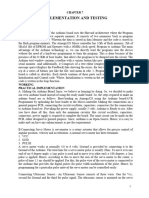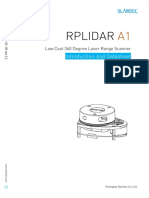Arduino LIDAR - Arduino Project Hub
Uploaded by
José Luis Zárate MoyaArduino LIDAR - Arduino Project Hub
Uploaded by
José Luis Zárate MoyaArduino LIDAR
A few things about LiDAR
LIDAR (Light Detection and Ranging) is an optical remote sensing system which
can measure the distance of a target by illuminating it with light. LIDAR
technology is being used in Robotics for the perception of the environment as
well as object classification. The ability of LIDAR technology to provide 2D
elevation maps of the terrain, high precision distance to the ground, and
approach velocity can enable safe landing of robotic and manned vehicles with a
high degree of precision.
LIDAR consists of a transmitter which illuminates a target with a laser beam,
and a receiver capable of detecting the component of light which is essentially
coaxial with the transmitted beam. Receiver sensors calculate a distance, based
on the time needed for the light to reach the target and return. A mechanical
mechanism with a mirror sweeps the light beam to cover the required scene in a
plane or even in three dimensions, using a rotating nodding mirror.
One way to measure the time of flight for the light beam is to use a pulsed laser
and then measure the elapsed time directly. Electronics capable of resolving
picoseconds are required in such devices and they are therefore very expensive.
Another method is to measure the phase shift of the reflected light.
Collimated infrared laser is used to the phase-shift measurement. For surfaces,
having a roughness greater than the wavelength of the incident light, diffuse
reflection will occur. The component of the infrared light will return almost
parallel to the transmitted beam for objects.
The sensor measures the phase shift between the transmitted and reflected
signals. The picture shows how this technique can be used to measure distance.
The wavelength of the modulating signal obeys the equation:
c = f ∙ τ
where c is the speed of light and f the modulating frequency and τ the known
modulating wavelength.
The total distance D' covered by the emitted light is:
D' = B + 2A = B + (θ * τ) / 2π
where A is the measured distance. B is the distance from the phase measurement
unit. The required distance D, between the beam splitter and the target, is
therefore given by
D = τ * θ / 4π
where θ is the electronically measured phase difference between the transmitted
and reflected light beams.
It can be shown that the range is inversely proportional to the square of the
received signal amplitude, directly affecting the sensor’s accuracy.
(copied from http://home.roboticlab.eu/en/examples/sensor/lidar).
As a part of my final year project i need the 2D map of surrounding for my
autonomous vehicle, so i choose LiDAR because it is so fast and accurate. Unlike
sonars that bounce ultrasonic waves, the 'cone' of sensing is very narrow.
VL6180x or Vl53l0x is an optical sensor from STMicroelectronics .VL53L0x is
much more precise and doesn't have linearity problems or 'double imaging'
where you can't tell if an object is very far or very close.
This time of flight sensor is actually used in our mobile phone to adjust the focus
of the camera.
Circuit Diagram
Install Adafruit library
Arduino code
#include <Wire.h>
#include "Adafruit_VL6180X.h"
#include <Servo.h>
Adafruit_VL6180X vl = Adafruit_VL6180X();
Servo myservo;
float pos = 0;
const float Pi = 3.14159;
void setup() {
myservo.attach(9);
Serial.begin(115200);
while (!Serial) {
delay(1);
}
if (! vl.begin()) {
while (1);
}
}
void loop() {
for (pos = 0; pos <= 180; pos += .5) {
myservo.write(pos);
uint8_t range = vl.readRange();
Serial.println(String(range)+"p"+String(pos*Pi/180)+"p"+String(pos));
delay(10);
}
/*for (pos = 180; pos >= 0; pos -= .5) {
myservo.write(pos);
uint8_t range = vl.readRange();
{
Serial.println(String(range)+"p"+String(pos*Pi/180)+"p"+String(pos));
delay(10);
}
}*/
myservo.write(0);
delay(2000);
}
Processing code (refer other radar project if u need good radar interface)
change the Arduino port number (eg "COM 3") before running.
import processing.serial.*;
Serial myPort;
String val;
int range,i=0;float pos;
void setup(){
size(550,500);
String portName = "COMx";//x=your arduino port number
myPort = new Serial(this, portName, 115200);
background(255);
}
void draw(){
if ( myPort.available() > 0) {
val = myPort.readStringUntil('\n');
if(val!=null)
{ String[] nums=split(val,"p");//splitting the recevied data searated by 'p'
if(nums.length==3)
{
range=int(nums[0]); //string to integer conversion
pos=float(nums[1]);
i=int(nums[2]);
if(i==180){
background(255);
}
}
}
}
translate(25,-50);
line(250,500,250-2*(range*cos(pos)),500-2*(range*sin(pos)));
}
The speed of sensor is limited to 10Hz and the response of servo is poor at higher
speed. If any one planning to make high speed LIDAR use stepper motor or DC
motors with feedback system. use slip rings for continuous rotation
(https://www.adafruit.com/product/736).
Any questions, suggestions are welcome!
You might also like
- Develop Routine of TF-Luna in Arduino: Step 1: Hardware ConnectionNo ratings yetDevelop Routine of TF-Luna in Arduino: Step 1: Hardware Connection6 pages
- Radar System Using Arduino UNOand Ultrasonic SensorNo ratings yetRadar System Using Arduino UNOand Ultrasonic Sensor12 pages
- Robot Operating System ROS Compatible Low Cost RotNo ratings yetRobot Operating System ROS Compatible Low Cost Rot6 pages
- Department of Computer Science EngineeringNo ratings yetDepartment of Computer Science Engineering16 pages
- The physics behind a radar system using Arduino involves the principles of wave propagationNo ratings yetThe physics behind a radar system using Arduino involves the principles of wave propagation2 pages
- Object Detection and Counting Using ESP8266 and TF Luna LiDAR (2)No ratings yetObject Detection and Counting Using ESP8266 and TF Luna LiDAR (2)7 pages
- Yoo2018 Article MEMS-basedLidarForAutonomousDrNo ratings yetYoo2018 Article MEMS-basedLidarForAutonomousDr8 pages
- Obstacle Sensed Switching in Industrial ApplicationsNo ratings yetObstacle Sensed Switching in Industrial Applications68 pages
- Object_Avoiding_System_Synopsis_Vishal(1DB22AD061)_pagenumber[1]No ratings yetObject_Avoiding_System_Synopsis_Vishal(1DB22AD061)_pagenumber[1]11 pages
- Batch4_Object detection using Arduino and Servo MinimotorNo ratings yetBatch4_Object detection using Arduino and Servo Minimotor2 pages
- 2B Mini Project Report 22-23 Arduino Based Tachometer 4 PDFNo ratings yet2B Mini Project Report 22-23 Arduino Based Tachometer 4 PDF18 pages
- Adafruit vl53l0x Micro Lidar Distance Sensor BreakoutNo ratings yetAdafruit vl53l0x Micro Lidar Distance Sensor Breakout21 pages
- A Progress Review On Solid State LiDAR and Nanophotonics Based LiDAR SensorsNo ratings yetA Progress Review On Solid State LiDAR and Nanophotonics Based LiDAR Sensors24 pages
- Nanophotonics For Light Detection and Ranging Technology: Review ArticleNo ratings yetNanophotonics For Light Detection and Ranging Technology: Review Article17 pages
- Proximity Sensor Project: Using Sharp Distance Measuring Sensor Unit (Analog Output Type) and Arduino Uno Board100% (1)Proximity Sensor Project: Using Sharp Distance Measuring Sensor Unit (Analog Output Type) and Arduino Uno Board15 pages
- Department of Electronic Engineering: "Design of An Arduino Based Radar System"0% (1)Department of Electronic Engineering: "Design of An Arduino Based Radar System"8 pages
- Sri Indu Institute of Engineering and TechnologyNo ratings yetSri Indu Institute of Engineering and Technology21 pages
- Light Detection & Ranging SEMINAR REPORTNo ratings yetLight Detection & Ranging SEMINAR REPORT23 pages
- Radio Frequency Identification and Sensors: From RFID to Chipless RFIDFrom EverandRadio Frequency Identification and Sensors: From RFID to Chipless RFIDNo ratings yet
- Chipless Radio Frequency Identification Reader Signal ProcessingFrom EverandChipless Radio Frequency Identification Reader Signal ProcessingNo ratings yet
- Ray Tracing Graphics: Exploring Photorealistic Rendering in Computer VisionFrom EverandRay Tracing Graphics: Exploring Photorealistic Rendering in Computer VisionNo ratings yet
- Contactless Data and Power Transmission (48 V / 300 W) : Rotary Joint - BN 637490No ratings yetContactless Data and Power Transmission (48 V / 300 W) : Rotary Joint - BN 6374904 pages
- Spinner: Contactless Data & Power Transmission For Rotating ApplicationsNo ratings yetSpinner: Contactless Data & Power Transmission For Rotating Applications8 pages
- A Simple Vision-Based Algorithm For Decision Making in Flying DrosophilaNo ratings yetA Simple Vision-Based Algorithm For Decision Making in Flying Drosophila7 pages
- Part1. Building The Balance: 6-7 MinutesNo ratings yetPart1. Building The Balance: 6-7 Minutes17 pages
- The Demands of Society From The Teacher As A ProfessionalNo ratings yetThe Demands of Society From The Teacher As A Professional8 pages
- Ethical Codes of Conduct and Value SystemNo ratings yetEthical Codes of Conduct and Value System12 pages
- Defining Contemporary Art (Chapter 1 - Asynchronous) Aranas Stem CNo ratings yetDefining Contemporary Art (Chapter 1 - Asynchronous) Aranas Stem C4 pages
- GEK-132231 GE KV2c Encompass Meter Family - User Manual Rev 1.0No ratings yetGEK-132231 GE KV2c Encompass Meter Family - User Manual Rev 1.0131 pages
- PeopleCert Scrum Product Owner I - II - Flyer - Digital - 202211No ratings yetPeopleCert Scrum Product Owner I - II - Flyer - Digital - 2022112 pages
- Causes of Non-Numeracy of Grade 8 Students: Introduction and RationaleNo ratings yetCauses of Non-Numeracy of Grade 8 Students: Introduction and Rationale13 pages
- Investigating Mathematics With ClassWizNo ratings yetInvestigating Mathematics With ClassWiz20 pages
- In The Name of God, The Gracious, The MercifulNo ratings yetIn The Name of God, The Gracious, The Merciful31 pages
- Answer Any Two Full Questions, Each Carries 15 Marks.: Reg No.: - NameNo ratings yetAnswer Any Two Full Questions, Each Carries 15 Marks.: Reg No.: - Name2 pages
- Pre-K Class Rules Infographics by SlidesgoNo ratings yetPre-K Class Rules Infographics by Slidesgo35 pages
- Spe Aberdeen Well Decommissioning 2022 - The Future!: Technical ProgrammeNo ratings yetSpe Aberdeen Well Decommissioning 2022 - The Future!: Technical Programme8 pages
- Download Full Social Issues in Sport 3rd Edition Ron Woods PDF All Chapters100% (3)Download Full Social Issues in Sport 3rd Edition Ron Woods PDF All Chapters50 pages
- Biot-Savart Law As A Tool To Calculate The Matrix of Inductances and The Coupling Coefficient of Two Coaxial Solenoids With Arbitrary Cross SectionsNo ratings yetBiot-Savart Law As A Tool To Calculate The Matrix of Inductances and The Coupling Coefficient of Two Coaxial Solenoids With Arbitrary Cross Sections11 pages
- Test Bank For Intermediate Accounting Reporting and Analysis 2nd Edition Wahlen Jones Pagach 1285453824 9781285453828100% (44)Test Bank For Intermediate Accounting Reporting and Analysis 2nd Edition Wahlen Jones Pagach 1285453824 978128545382836 pages
- Chen Et Al. (1976) - Added Mass and Damping of A Vibrating Rod in Confined Viscous FluidsNo ratings yetChen Et Al. (1976) - Added Mass and Damping of A Vibrating Rod in Confined Viscous Fluids33 pages


































































































